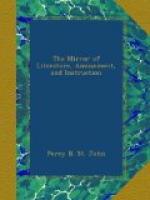[4] Here is the altar of wrought
silver, which was fortunately
rescued from the hands of
the French, when in possession of
Oporto.
[5] The annual average quantity of wine exported from Oporto to Great Britain, was in the ten years, 1813-1822, 24,364 pipes, and to all other parts of the world only 1,094 pipes per annum. The quantity since 1822 has not materially altered.—See a Communication to vol. xv. of the Mirror, p. 118.
“On the quays,” says Mr. Kinsey, “are seen fine blocks of granite, already converted into form, having their edges cased with wood, ready to be shipped off for buildings in Brazil, where it appears that no good stone, or, at least, so durable as this, can be procured;—pipe-staves from Memel,—flax and iron,—and occasionally coals from the north of England. There are generally at anchor in the river between Villa Nova and Oporto, Russian, Brazilian, English, American, Dutch, Danish, and some French vessels; but many of the latter nation are not to be found in the Portuguese ports. Two thirds of the shipping to be seen in the Douro, are British, Brazilian, or Portuguese.”
The gardens of the city are luxuriantly stored. Brazilian plants, easily distinguished by their gaudy colours, vines on trellis, superb lemon-trees, lime and orange-trees, pear, apple, and plum-trees, and Alpine strawberries are in abundance. The Indian cane, with its splendid blossom, whose colour resembles that of the Guernsey, or rather the Chinese lily, is a gay addition to the ornaments of this earthly paradise. Mr. Kinsey says “The ulmis adjungere vitem is well known in poetical description, but in Portugal, besides overshadowing their artificial supporters, the vines are seen attaching themselves




